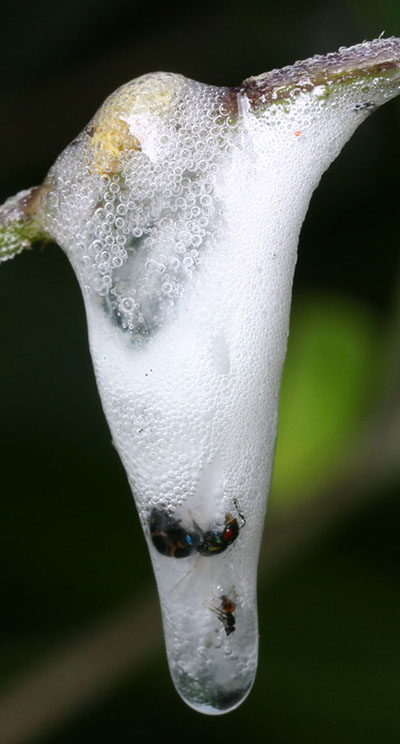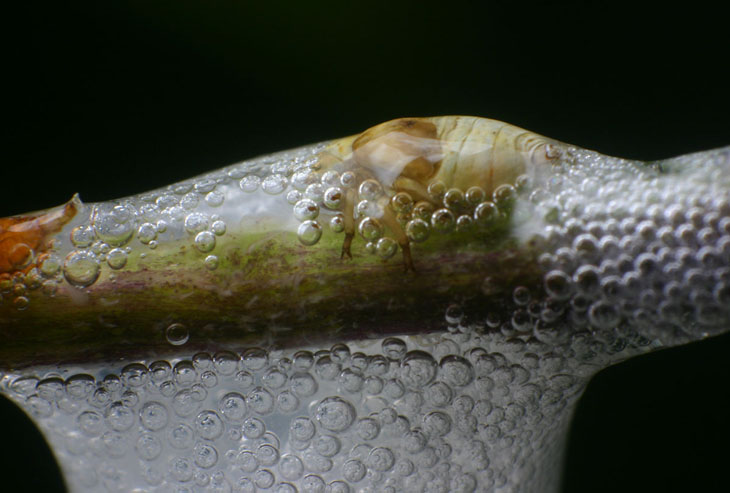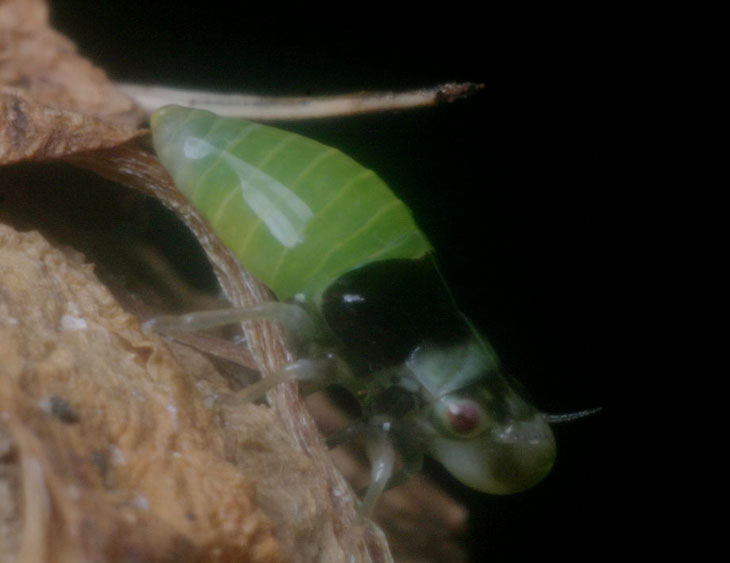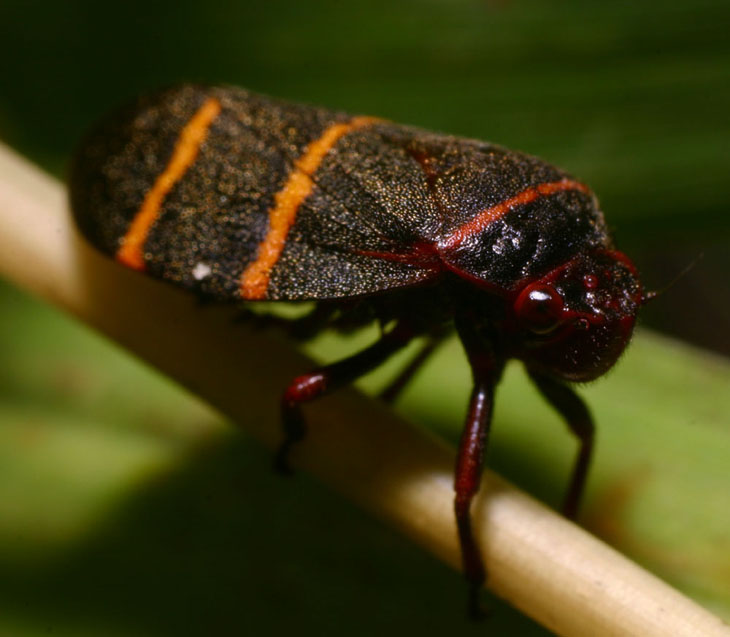 Well, okay, only if you’re a tiny arthropod and encounter it directly. No, that’s not exactly right either, because it’s hardly a grave, is it? Maybe I should have abandoned that title…
Well, okay, only if you’re a tiny arthropod and encounter it directly. No, that’s not exactly right either, because it’s hardly a grave, is it? Maybe I should have abandoned that title…
We’re going back in the photo archives for this one, seeing as how no one has gotten off their ass to ban winter. During warmer months, you may have spotted a blob of foam on a plant, often in the forks or at the base of leaf stems, and wondered what it was – it very likely appeared a little different from what I’m showing here, but this isn’t typical, it just illustrates traits a little better. Wonder no more, however, because what you saw was the protective behavior of a spittlebug nymph.
There are a few varieties, and I have no good method of identifying which species the nymph belongs to, so this will remain vague for now. They are hemipterans, ‘true bugs,’ meaning they have piercing/sucking mouthparts, in this case to draw out plant juices like the leafhoppers and cicadas do. Some time back I posted about the sharpshooters, and the volume of waste that they produce, and later about a curious substance produced by adult spittlebugs – these species are related and have similar feeding habits. Long story short: they feed on plant sap but derive very little sustenance from it, so they must cycle a lot of it through; basically, it means they’re almost perpetually weeing while feeding. The sharpshooters fling it away, the adult spittlebugs might simply drip, but the nymphs have developed an interesting defensive trait, which is to pump the stuff full of air and surround themselves with bubbles. In this image, two unidentified arthropods have run afoul of the sticky defense and drowned within – those are the two darker shapes towards the bottom of the drip – while the spittlebug nymph itself is the yellowish shape at the top.
From research just now, the nymph’s spit is likely acrid-tasting, certainly far more viscous than plant sap, but is there anything else to it? For instance, was it actually toxic to the two victims seen here or simply too sticky to escape from? As yet, I don’t know. I also don’t know how the sticky little bugger breathes while in there. I’ve commented before that most arthropods breathe through openings along their sides called spiracles, and in the case of the spittlebug it seems like it may be related to the shape of the plates along the underside of their abdomen called tergites (singular tergum.) This doesn’t help answer the question at all, since this is the last location I would think could be useful in breathing while submerged in sputum.

Here’s another look of the same one, as detailed as I could get while it remained protected under its self-generated blanket. Since it’s only a few millimeters long, it’s easy to imagine that spotting this at all would take the right light and a very close examination, but it’s much worse in most cases, since the bubbles are often thicker and more piled atop the insect.
 This is a different one that I had exposed earlier to see the detail – this was quite an involved exercise, starting with even locating the little guy among all the foam, then in carefully sweeping the remaining bubbles away with a blade of grass. While the adult produces a remarkably water-repellent substance to remain dry (seriously, click on that link, it’s very cool,) the nymph displays pretty much the opposite affect, never appearing to be dry at all. This one is already starting to regenerate its cocoon of bubbles, only moments after I’d exposed it for the photo – you can see them gathering along the branch. I have two vague suspicions fostered by this photo, and since I’m not at all entomologically-educated that’s all they are, but perhaps I can find out more come spring when these guys reappear. The first is that the protrusion from the hind end of the abdomen, while almost certainly producing the spit in the first place, may also be how the spittlebug breathes, occasionally extending up and out of the bubbles to draw in air (arthropods really don’t need much, and the large quantity needed for the bubbles is almost certainly ‘pumped’ rather than ‘exhaled.’) This might even be linked to the production of the brochosomes in the adult, at the least forming a repellent surface on the very end so it can easily poke free from the saliva. The second suspicion is that the swollen portion of the abdomen represents storage of liquid so that the nymph can quickly generate bubbles for protection, even while not actively drinking sap.
This is a different one that I had exposed earlier to see the detail – this was quite an involved exercise, starting with even locating the little guy among all the foam, then in carefully sweeping the remaining bubbles away with a blade of grass. While the adult produces a remarkably water-repellent substance to remain dry (seriously, click on that link, it’s very cool,) the nymph displays pretty much the opposite affect, never appearing to be dry at all. This one is already starting to regenerate its cocoon of bubbles, only moments after I’d exposed it for the photo – you can see them gathering along the branch. I have two vague suspicions fostered by this photo, and since I’m not at all entomologically-educated that’s all they are, but perhaps I can find out more come spring when these guys reappear. The first is that the protrusion from the hind end of the abdomen, while almost certainly producing the spit in the first place, may also be how the spittlebug breathes, occasionally extending up and out of the bubbles to draw in air (arthropods really don’t need much, and the large quantity needed for the bubbles is almost certainly ‘pumped’ rather than ‘exhaled.’) This might even be linked to the production of the brochosomes in the adult, at the least forming a repellent surface on the very end so it can easily poke free from the saliva. The second suspicion is that the swollen portion of the abdomen represents storage of liquid so that the nymph can quickly generate bubbles for protection, even while not actively drinking sap.

This is another nymph, though whether it’s the same species at a later instar, or a completely different species, I cannot say – I’m inclined to think it is at least a later instar because of the greater body detail. It also finally explained just what, exactly, this spider had captured, something that I’d been wondering about for a while (but no, it wasn’t enough to keep even me up nights.)

 Here are two images of adult form, in this particular case (since I can identify these) two-lined spittlebugs, Prosapia bicincta – one of which demonstrates scale quite nicely. Once again, this seems to be an example of aposematic coloration, the high-contrast and memorable ‘keepaway’ pattern that also signals a defensive trait – according to one source, this species is believed able to secrete its own ‘blood,’ or hemolymph, when disturbed. This is what the ladybeetles do, and apparently it’s foul-tasting. I haven’t had the pleasure, myself; as weird as I am, I’m no bug-licker (demonstrating that no matter how anemic your social graces, you can always find someone to sneer down upon.) This defense was certainly not enough to deter a fishing spider, but because of their capture and feeding method, I imagine a lot of such defenses won’t work with spiders.
Here are two images of adult form, in this particular case (since I can identify these) two-lined spittlebugs, Prosapia bicincta – one of which demonstrates scale quite nicely. Once again, this seems to be an example of aposematic coloration, the high-contrast and memorable ‘keepaway’ pattern that also signals a defensive trait – according to one source, this species is believed able to secrete its own ‘blood,’ or hemolymph, when disturbed. This is what the ladybeetles do, and apparently it’s foul-tasting. I haven’t had the pleasure, myself; as weird as I am, I’m no bug-licker (demonstrating that no matter how anemic your social graces, you can always find someone to sneer down upon.) This defense was certainly not enough to deter a fishing spider, but because of their capture and feeding method, I imagine a lot of such defenses won’t work with spiders.
So the next time you see that little cluster of bubbles on a plant, you can point to it and say authoritatively, “That is a spittlebug.” Chances are, someone will think you’re just trying to be funny, but those that don’t might start asking a lot of questions that I haven’t answered here, and you’ll have to pretend you can’t hear them (it works for me.) Hopefully, before that occurs I’ll have found more examples and done some closer examinations to answer that breathing question; then, your opening is, “You may ask how this insect breathes while surrounded by viscous foam, and that’s an astute question,” which will make them feel all sheepish because they weren’t about to ask that at all. Put ’em on the defensive, right off the bat.



















































